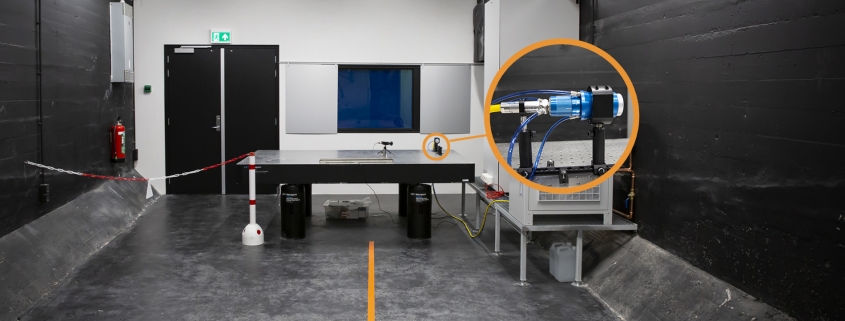On Thursday 20 September, the Netherlands Aerospace Centre (NLR) opened its new High-Energy Laser (HEL) laboratory to the press. The HEL lab has been in use since July 2018. During a demonstration a small flying drone was shot down by a HEL. With this new facility, NLR is contributing to a key objective of the armed forces of the Netherlands and the Dutch Ministry of Justice & Security: effectively protecting civilians and military personnel against weapons and platforms deployed by enemy states and terrorists to penetrate Dutch airspace. Using this new generation of Solid-State Lasers, the armed forces can within seconds destroy a target such as a rocket or enemy drone. No more ammunition is needed, a nearby electricity socket is sufficient. Well-equipped lab
NLR will develop its expertise in HEL systems in the secure HEL lab, which consists of a control room and a laser room. The eye-catcher in the laser room is a large laser cabinet, which converts mains electricity into a laser beam. This 1 kW beam is routed via a cable to a ‘collimator’, a device similar to a laser gun which narrows a beam of particles or wave. The source strength of the laser beam is sufficient to burn a hole in a metal plate over a distance of 15 metres (the length of the laser room) within a few seconds. The efficiency of the laser source is about 30 percent. This means that a lot of residual heat is released that needs to be cooled. This is done using a ‘chiller’, which supplies water at 20 degrees Celsius to the laser cabinet. Finally, the gases released during the laser process are filtered and released to the atmosphere.
Research into next-generation lasers
NLR will use the HEL lab to conduct research into the applications and effects of this new generation of lasers. For example, NLR will investigate how the quality of the laser beam is affected by atmospheric conditions such as the presence of water molecules. These can reflect part of the beam, making it less concentrated and less powerful. In addition, NLR will validate models to provide standard data on how long it takes, for example, to burn a hole in a metal plate of a specific size and thickness. NLR will also direct laser beams at relevant targets and will investigate the dangers associated with the reflections that are released when protecting an area with an HEL system, for instance. Finally, NLR will develop knowledge about protective measures against enemy use of HEL systems.
Lasers for self-protection
NLR is also investigating how unarmoured platforms of the armed forces can use lasers for protection against enemy weapons systems. In doing so, account must be taken of space limitations and the resulting restrictions on the integration of both the laser device, tracking system and the cooling system.
See also this video
 NLR
NLR
 Airbus
Airbus NLR
NLR